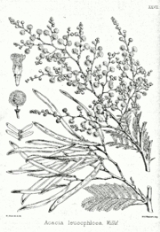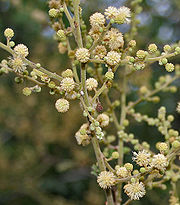
Acacia leucophloea
Encyclopedia
Acacia leucophloea also called reonja, is a moderate sized tree
sometimes mistaken for prosopis cineraria
with spreading crown and somewhat malformed and crooked trunk.
 It attains a height of about 20 to 30 ft and a girth of 2 to 3 ft. New leaves appear in April, and yellowish white flowers appear from August to October. The pods ripe by April and the seeds germinate readily if moisture is available. The tree is very hardy and stands drought well. It is frost hardy except in young age. It coppices well and produces good root
It attains a height of about 20 to 30 ft and a girth of 2 to 3 ft. New leaves appear in April, and yellowish white flowers appear from August to October. The pods ripe by April and the seeds germinate readily if moisture is available. The tree is very hardy and stands drought well. It is frost hardy except in young age. It coppices well and produces good root
sucker
s. It suffers from goat browsing particularly in early stage. Fruits are thin, flat, curved tomentose pods (difference from prosopis cineraria
).
Tree
A tree is a perennial woody plant. It is most often defined as a woody plant that has many secondary branches supported clear of the ground on a single main stem or trunk with clear apical dominance. A minimum height specification at maturity is cited by some authors, varying from 3 m to...
sometimes mistaken for prosopis cineraria
Prosopis cineraria
Prosopis cineraria is a species of flowering tree in the pea family, Fabaceae, that is native to arid portions of Western and South Asia, such as the Arabian and Thar Deserts...
with spreading crown and somewhat malformed and crooked trunk.

Root
In vascular plants, the root is the organ of a plant that typically lies below the surface of the soil. This is not always the case, however, since a root can also be aerial or aerating . Furthermore, a stem normally occurring below ground is not exceptional either...
sucker
Basal shoot
A basal shoot, root sprout, adventitious shoot, water sprout or sucker is a shoot or cane which grows from a bud at the base of a tree or shrub or from its roots. This shoot then becomes, or takes the form of, a singular plant. A plant that produces suckers is referred to as surculose...
s. It suffers from goat browsing particularly in early stage. Fruits are thin, flat, curved tomentose pods (difference from prosopis cineraria
Prosopis cineraria
Prosopis cineraria is a species of flowering tree in the pea family, Fabaceae, that is native to arid portions of Western and South Asia, such as the Arabian and Thar Deserts...
).

